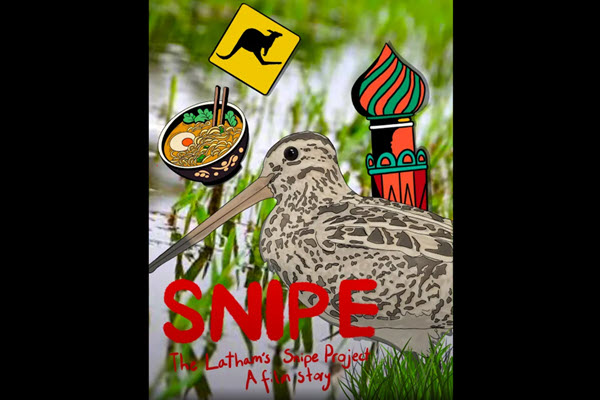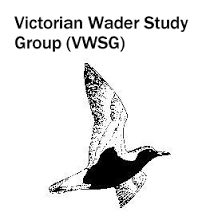
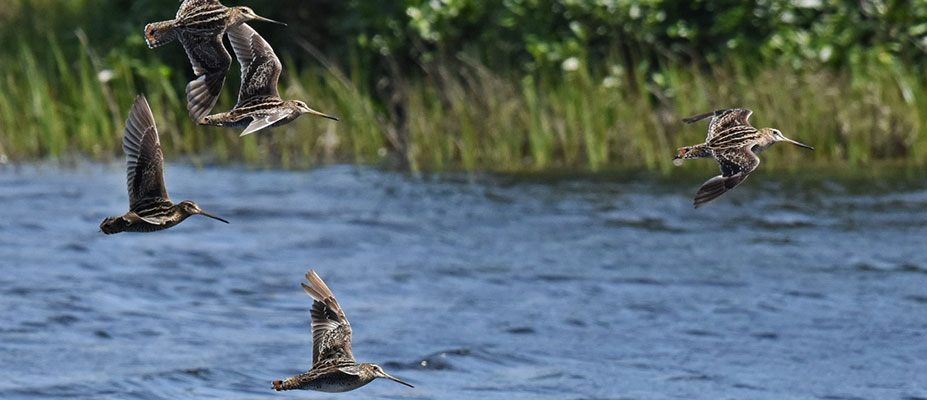
Tracking the Migration of Latham's Snipe
The Latham's Snipe project was initiated to better understand the ecology and habitat use of Latham's snipe (Gallinago hardwickii), a shorebird species that breeds in Japan and migrates to Australia for the austral spring-summer. Using a combination of tracking techniques including light-level geolocators and satellite transmitters, the first ever migration tracks for the species have been obtained. The Latham's Snipe Project is supported by CeRDI, the Australia Japan Foundation and the Woodland and Wetlands Trust.
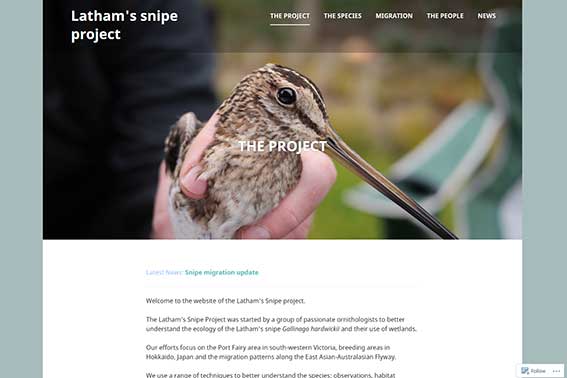 |
Background
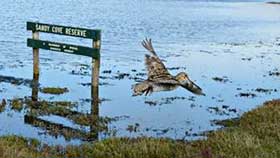 | |
Latham’s Snipe in Port Fairy. | |
The research to track the migration patterns of the Latham's snipe (Gallinago hardwickii) is being coordinated by Dr Birgita Hansen, senior research fellow at CeRDI. The Latham's snipe project is a collaboration between researchers, ornithologists, and community groups. The team works collaboratively with colleagues from the Wild Bird Society of Japan (WBSJ) and in eastern Russia. This has enabled the exchange of researchers and research expertise between Australia and Hokkaido, Japan, facilitating activities associated with the snipe research, and delivering shorebird conservation education to school students. Visits to both Japan and Sakhalin Island (eastern Russia) have provided valuable observations and data for the project, furthering strengthening these collaborations.
The Latham's snipe project was initiated in the wake of a Victorian Civil and Administrative Tribunal case in 2014, regarding a housing development proposal on an important Latham's Snipe wetland (Powling Street wetlands) in Port Fairy, south-west Victoria. During the case, proponents claimed that the housing development would not impact the snipe population because the birds would move to another site. However, there was no evidence to support this claim.
In September 2014, a series of counts was conducted around the Port Fairy and Warrnambool region to determine the relative importance of urban wetlands like the Powling Street wetlands. These counts revealed that over 95% of the population occurred in urban wetlands during the day. Based on this discovery, the count program was extended to the following year to determine if these patterns of wetland use were consistent between years.
Since the 2015-2016 season, the survey program has continued and now encompasses over 300 sites across six eastern states and territories. These (now) national snipe surveys provide important insights into the distribution and abundance of Latham’s Snipe, particularly in the southern states where the monitoring efforts have been greatest. Large numbers of snipe have been recorded at some sites - often in urban areas - and frequently at sites with no official protection. There are 14 sites with at least one record of 80+ snipe, and there are 62 sites with one or more records ≥18 snipe. A count of 18 or more birds at a site is recognised as nationally significant under the Environment Protection and Biodiversity Conservation Act 1999.
The project also expanded to include a capture and tagging program aimed at investigating snipe migration and movements. Bird monitoring was initially undertaken using data loggers called light-level geolocators, which were deployed on snipe in Port Fairy during spring 2015 and 2016, and then at the Jerrabomberra wetlands in Canberra in summer 2017-2017 and 2017-2018. Recapture of birds is required to retrieve the light data from the logger and reconstruct the migration route. Although 54 devices were deployed, only three were retrieved and only two of these contained full migration tracks. The first device retrieved from snipe T0 yielded a full year of light data, which was analysed to determine the latitude and longitude of the bird over that period.
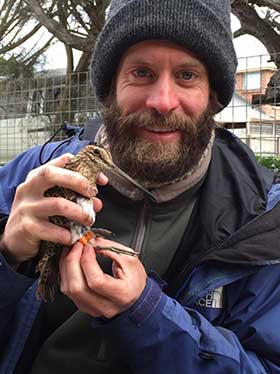 |
Richard Chamberlain with Latham’s |
 |
|
Given the low retrieval rates of geolocators, the Latham’s Snipe project team introduced satellite tracking. A trial using solar Platform Transmitter Terminals was undertaken in 2017, which produced data showing an unexpected stopover record in Gwydir wetlands (northern NSW). A subsequent trial with PinPoint Argos GPS devices in 2019 and 2020 was more revealing even though no full migration tracks were obtained. Snipe were found to use a variety of locations for stopping over during migration including Gwydir wetlands, Cape York, and the Papua New Guinean highlands. In 2021, GPS tags were again deployed and as of January 2022, there were two snipe at Jerrabomberra wetlands ![]()
|
The figure above shows individual Latham’s snipe tracks and stopover locations in assorted colours, collated from data obtained between 2017 and 2022. The grey hatched circles show the regions where evidence of staging by individual snipe (i.e. stopping over for 2 weeks or more) has been recorded.
Radio tracking was also undertaken in 2016-2018. The radio tracking for snipe at Port Fairy was conducted over two seasons and revealed very distinct partitioning of habitat use by snipe between daytime roost sites and night-time foraging sites. Radio tracking was also trialled in Canberra but was less successful due to transmission interference. Nevertheless, the cumulative insights from both the radio and satellite tracking revealed a common pattern of different habitat use by snipe in the daytime and at night-time.
During the research, two honours research projects have been conducted by students. One by Andrew Crossley who conducted the radio tracking in Port Fairy and included sampling of wetland vegetation characteristics at different sites. This complements a report undertaken by Dr Michelle Casanova which comprehensively measured vegetation communities at key Port Fairy sites.
The second honours project, conducted by Michelle Matthews, delved into the history of snipe hunting through interviews with snipe hunters, and how hunting changed with the introduction of the Japan Australia Migratory Bird Agreement in the early 1980s.
Outcomes
Key findings from the Latham’s Snipe project:
- The National Snipe surveys have revealed that large congregations of snipe during daylight hours mostly occur in urban wetlands;
- Sites supporting nationally significant numbers of snipe are rarely protected;
- Snipe migration occurs as direct flights over the Pacific Ocean between Australia and Japan, with extended stopovers for ‘refuelling’ in northern NSW, south-eastern Queensland, Cape York, and Papua New Guinea;
- The characteristics of wetlands used by snipe during the day differ to those of wetlands used during the night, when birds forage;
- Snipe are flying only minimal distances to night-time feeding sites, and most return to the same roosting site each day; and
- Some snipe appear to be highly ‘site faithful’, whilst others may transit through an area on their way to other non-breeding areas in southern Australia.
The Latham's Snipe project is supported by many dedicated counters and volunteers. As the project continues to acquire new knowledge about the species, the people participating in counts and catches has grown. There is now an extended network of volunteers across eastern Australia contributing to the monitoring of snipe, many with expertise in snipe observation and catching.
The project has also been successful in engaging local communities including school children in the Canberra Young Rangers program. This is an important outcome of the project as it increases engagement with the public about wetland habitat protection for snipe conservation.
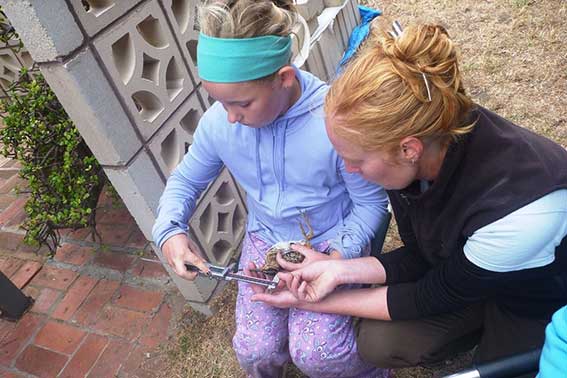 |
Project lead Dr Birgita Hansen helping Young Ranger Kelly Bateup to measure a snipe. Photo Lori Gould. |
Innovation
The Latham's Snipe project takes an unusual and innovative approach to investigating the migration and habitat use of this species. By building a collaboration with community groups from the outset, the project has established a research and monitoring program that combines traditional scientific approaches with community-based monitoring to answer questions about the species ecology and conservation. This is a rare example of a successful co-designed project.
Approach
The Latham's Snipe project has used several strategies to address its objectives. The most critical of these has been to establish the project as a partnership between academic research and community groups. This has been achieved through a co-design approach that draws upon years of knowledge and expertise gained by community members which is combined with traditional scientific research.
Three complementary methods have been used to investigate the ecology and migration of Latham's Snipe:
- The national survey program focused on longitudinal monitoring at >150 sites across the species’ non-breeding range in eastern Australia;
- Capture-based studies to learn about the demographics of the population in Port Fairy and Canberra, using devices for tracking movement at local (daily) and continental scales; and
- Habitat assessments to determine wetland characteristics favoured by snipe.
Information from counts conducted by the South Beach Wetlands and Landcare Group formed the basis for designing a survey program that focused on a range of sites where snipe were present and absent. The group's observations over time were critical to determining how to design a capture-based program aimed to deploying geolocators, which require re-capture of the bird and hence, knowledge of the bird's behaviour from year-to-year.
In addition to Australian studies, the Latham's Snipe project team visited Hokkaido, Japan in 2016 and 2018, to assist the Wild Bird Society of Japan (WBSJ) with their snipe research. In turn, the WBSJ team visited Canberra in 2017 and 2020. During the second visit they were accompanied by some of the Japanese School children first met in 2017. These reciprocal visits have strengthened ties between the two countries and provided the Australian team with many insights and added information about snipe in Japan. Furthermore, Dr Hansen has visited the island of Sakhalin in eastern Russia (north of Hokkaido) and conducted opportunistic surveys of snipe with Russian colleagues.
The Latham's Snipe project has combined a variety of research and monitoring approaches, including observation, survey, geolocator studies, radio tracking and satellite tracking, to increase our knowledge of the species.
Future Directions
Research for the Latham's Snipe project is expanding in 2022. A PhD project based at the Australian National University Canberra, will investigate the broader ecology of the species and building upon the movement ecology knowledge generated to date.
The priorities for future research include:
- Analysis and publication of information obtained from the national surveys, the Port Fairy radio tracking and wetland vegetation assessments, the satellite tracking and the social research on hunting and JAMBA;
- A review of the conservation and policy status of the world’s snipe and woodcock species;
- An investigation into alpine and highlands snipe populations in Australia.
- Establishing a print exchange between Australia and Japan, via the Overwintering Project

If you are interested in getting involved in the Latham’s Snipe Project, either as a collaborator, a student researcher, or a volunteer, please contact Birgita via email: b.hansen@federation.edu.au
Team Members
PRESENTATIONS
Hansen B, Tajiri H, Ura T, Honan J, Wilson D, Chamberlain R, Stewart D, Veltheim I, Taws N, Gould L. (2020) New evidence of Papua New Guinea as a key staging site for migrating Latham’s Snipe. 1st East Asian-Australasian Flyway Shorebird Science Meeting, Seocheon-gun, Republic of Korea. November 3-5, 2020. Online.
Hansen B, Tajiri H, Ura T, Honan J, Wilson D, Chamberlain R, Stewart D, Veltheim I, Taws N, Gould L. (2020) New evidence of Papua New Guinea as a key staging site for migrating Latham’s Snipe. International Shorebird Twitter Conference, British Ornithological Union, 7-8 October 2020. Online.
Hansen B, Honan J, Wilson D, Stewart D, Crossley A, Chamberlain R, Ura T, Takemae A, Tajiri H, Davey C, Gould L. (2019). An overview of movement and migration knowledge from the Latham’s Snipe Project. Australasian Ornithological Conference, Darwin. 1-5 July 2019.
Hansen B (2019). Satellite transmitter harness design and short-term housing for Latham’s Snipe (poster). Australasian Ornithological Conference, Darwin. 1-5 July 2019.
Hansen B, Wilson D, Honan J, Chamberlain R, Stewart D, Gould L, Crossley A. (2019) Ecology and migration of Latham’s Snipe in Australia. Wild Bird Society of Japan, Tokyo, Japan. April 2019.
Hansen B, Gould L, Davey C, Honan J, Chamberlain R, Stewart D. (2018) The Latham’s Snipe national surveys. Australasian Shorebird Conference, Hobart. 27-28 October 2018.
Hansen B, Wilson D, Honan J, Chamberlain R, Stewart D, Gould L. (2017) Building an understanding of habitat use, movement and migration of Latham’s Snipe. Australasian Ornithology Conference, Geelong. 8-11 November 2017.
Hansen B, Honan J, Stewart D. (2015) What is the relative importance of urban wetlands for Latham’s Snipe in south-west Victoria? Australasian Ornithological Conference. Adelaide. 25-28 November 2015.
RESEARCH OUTPUT
Hansen, B. (2021) This bird’s stamina is remarkable: it flies non-stop for 5 days from Japan to Australia, but now its habitat is under threat. The Conversation. 30 Aug 2021
https://theconversation.com/this-birds-stamina-is-remarkable-it-flies-non-stop-for-5-days-from-japan-to-australia-but-now-its-habitat-is-under-threat-165964

Hansen B, Ura T, Tajiri H, Dutson G, Garnett ST (2020) Latham’s Snipe Gallinago hardwickii. In Action Plan for Australian Birds 2020. (Eds ST Garnett and GB Baker) pp. 297-300. CSIRO Publications, Melbourne.
Hansen, B.D., Reviakina, Z., Kulikova, O., Ktitorov, P. (2020) An overview of the Latham’s Snipe population in Sakhalin, Eastern Russia. Stilt 73-74, 52-28.
Hansen B (2020) The Latham’s Snipe Project migration and movement studies. Cumberland Bird Observers Club Inc. Newsletter 42, 1-6.
Hansen B. (2019) The Latham’s Snipe Project migration and movement studies. Queensland Wader 109, 1-3.
Hansen B. (2019) What are we learning from the Latham’s Snipe Project? Geelong Naturalist June 2019, 12-13.
Honan, J. (2018) Collaborative research produces exciting results. Victorian Landcare and
Catchment Management 72, 6-7.
Hansen, B. (2017) Site fidelity, migration, movement and habitat preference of Latham’s Snipe: the story so far. Wader Quest Newsletter 4, 12-14.
Wilson, D., Hansen, B., Honan, J. Chamberlain, R. (2017). 170 years of Latham's Snipe Gallinago hardwickii arrivals in New South Wales and the Australian Capital Territory show no change in arrival date. Australian Field Ornithology 34, 76-79.
Hansen, B. (2016). Latham's Snipe tracking project — news brief. Wader Quest Newsletter 3, 17.
Hansen, B., Honan, J., Wilson, D., Chamberlain, R., Stewart, D., Gould, L. (2016). Konnichiwa Ojishigi: following Latham's Snipe from Japan to Australia. Tattler 41, 13-14.
Hansen, B. (2016). Latham's Snipe use of urban versus non-urban wetland habitat in Victoria. Tattler 38, 15.
Hansen, B. (2015). Latham's Snipe count results. Geelong Naturalist 51(8), 9.
Hansen, B., Wilson, D., Koyama, K. (2015). Australian researchers to study Latham's snipe migration. Bird Research Water Bird News. Oct. 2015. Japan Bird Research Association.
Hansen, B., Veltheim, I. (2015). Wetlands, brolgas and Latham's snipe: south-west Victoria's great natural assets. Pp. 57-58 In: Wetlands Australia, National Wetlands Update February 2015 — Issue No 26, Commonwealth of Australia 2015.
Hansen, B. (2015). Latham's Snipe and urban wetlands in the Port Fairy Region. VWSG Bulletin 38, 73-74.
NEWS
Visit the Latham's snipe project news web page to see the latest news from this project https://lathamssnipeproject.wordpress.com/news/

Federation in partnership with the Tasmanian Land Conservancy - 24 September 2025
CeRDI’s Dr Birgita Hansen has established a new research program to investigate the ecology and habitat use of Latham’s Snipe... Continue reading...
Showcasing citizen science contributions to the Latham's Snipe - 24 September 2025
Australian citizen scientists have been making important contributions to the conservation of migratory shorebird species, Latham's Snipe... Continue reading...
Advancing the conservation of Latham's Snipe - 13 March 2025
Improving knowledge about the ecology and migration to support conservation of the species.... Continue reading...
Birgita talks Latham's Snipe in Tasmania and Werribee - 17 December 2024
CeRDI Senior Research Fellow Dr Birgita Hansen, leader of the Latham’s Snipe Project, visited Hobart, Tasmania during early November. ... Continue reading...
Latham Snipe research: Documentary and podcast - 9 October 2024
The Latham's Snipe research, led by CeRDI's Dr Birgita Hansen, has been featured in a new documentary film, and an informative podcast... Continue reading...
Tracking the endangered Australian Painted-snipe - 13 December 2022
Research to track of one of the world's rarest and little know birds: the Australian Painted-snipe.... Continue reading...
Latham's snipe project: Successful summer capture - 10 March 2020
During early January 2020 the Latham's Snipe project team braved the heat and smoke of Canberra to catch Latham's Snipe... Continue reading...
Researchers elated by Latham's Snipe recapture - 9 January 2019
Researchers working on the Latham's Snipe migration tracking project make an exciting and significant research advancement.... Continue reading...
Latham’s Snipe research team visit Japan - Winter 2018
A team of researchers, led by CeRDI’s Dr Birgita Hansen, together with school-aged children from the Canberra Young Rangers, recently visited Hokkaido, Japan. Continue reading...
Latham’s snipe research update - Autumn 2017
The Latham’s snipe project commenced in 2015 with the aim of obtaining information on migratory patterns of the Latham’s snipe (Gallinago hardwickii), a shorebird that migrates to the Japan from Australia, and has resulted in the first ever full migration track for the species. Continue reading ..
VIDEOS
Tracking the Migration of Latham's Snipe (8:56)
Hokkaido Television Broadcasting have produced a short YouTube documentary on their visit to Canberra in January 2017.
SNIPE - The Latham's Snipe Project (24:21)
This is the story of a bird that breeds in Japan and Eastern Russia, and then flies to Australia each year. After spending summer in Australia, it goes back to the Northern Hemisphere and does it all again!
PARTNERS
South Beach Wetlands and Landcare Group

The South Beach Wetlands and Landcare Group is a key partner on the Latham’s Snipe project, providing knowledge, funding through Landcare, field assistance and access to landholder networks.
Victorian Wader Study Group

The Victorian Wader Study Group is a partner to the project through the Group’s long-term scientific program on waders and terns. The Latham’s Snipe project field activities form part of the VWSG’s monitoring program.
Wild Bird Society of Japan

The Wild Bird Society of Japan is a collaborator on the Latham’s Snipe project through contribution to field study, knowledge sharing and reciprocal exchange of researchers.
Woodlands and Wetlands Trust (Jerrabomberra Wetlands)

The Woodlands and Wetlands Trust (Jerrabomberra Wetlands) is a partner on the Latham’s Snipe project through its snipe program in Canberra and provision of funding to support the project.
Australia Japan Foundation

The Australia Japan Foundation is the key funding partner on the Latham’s Snipe project, supporting field-based engagement activities and exchange of Australian and Japanese scientists.


